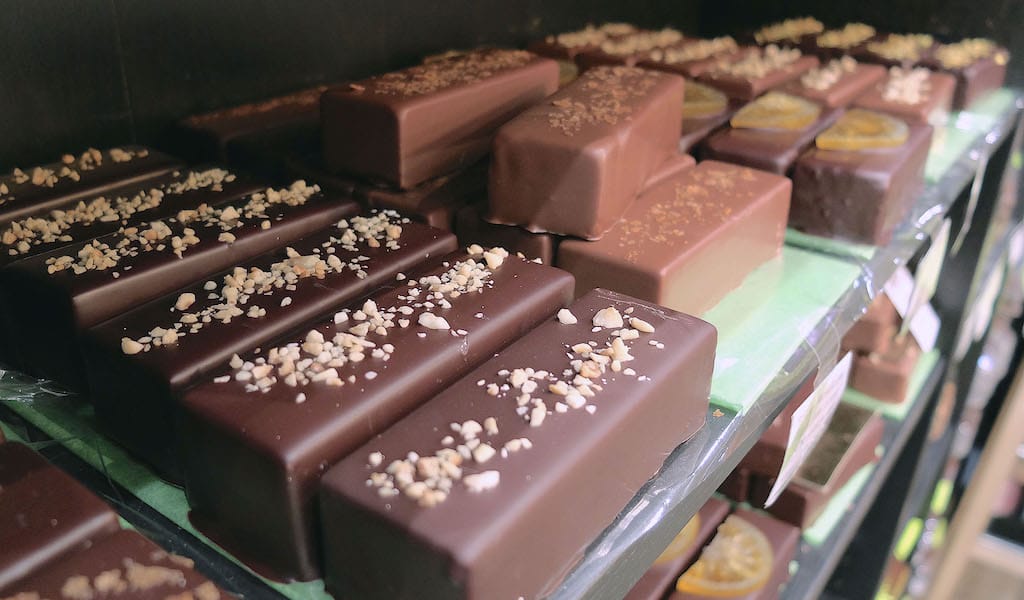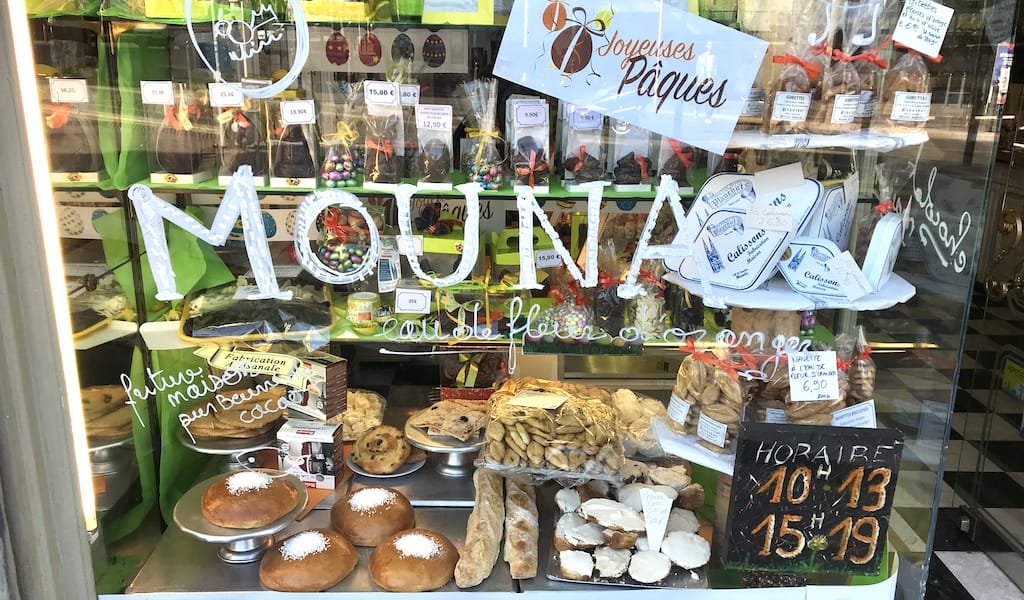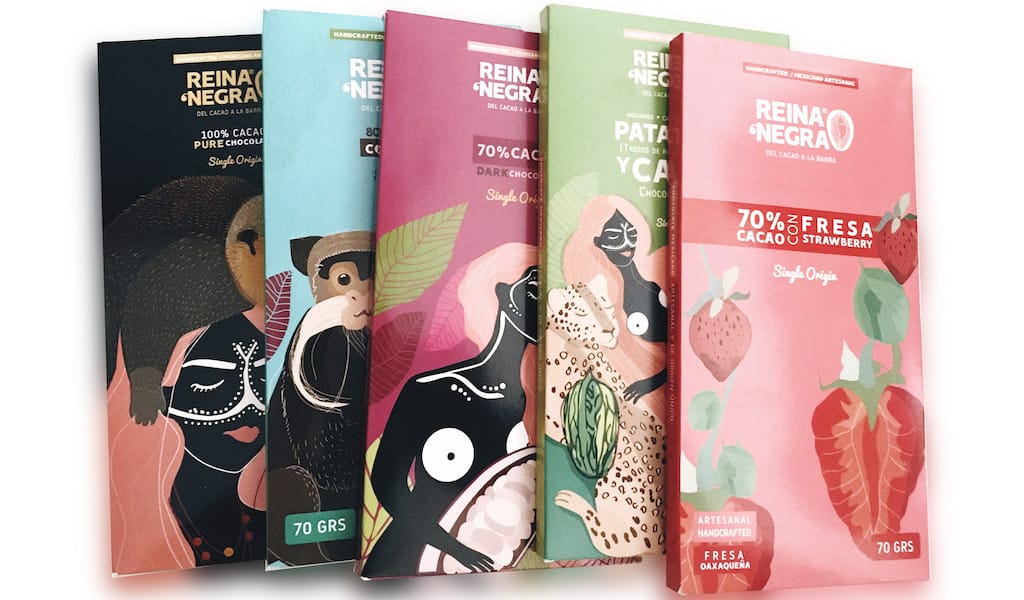When we first moved to Marseille, a jewel box of a shop caught our eye while wandering around the Vieux-Port. Its window display was stacked with chocolates: smooth rectangular bars, green and brown olivettes (chocolate-covered almonds) and slabs studded with every kind of nut. When a customer opened the door to leave, the strong scent of cocoa hit our nostrils, luring us inside.
The artisanal chocolate shop, named La Chocolatière de Marseille, is run by Alain and Zerrin Semerciyan. All the chocolates are made upstairs, hence the alluring aromas that perfume the shop. Since 2014, the couple has developed a faithful clientele for their delicious wares: slabs (tablettes) of dark, milk and white chocolate traditional to European chocolatiers, orange rinds (orangettes) dipped in chocolate, and the barre marseillaise, a delicacy that can only be found in Marseille.
Alain, a Marseillais of Armenian descent (the city has been home to a large Armenian community since the early 20th century) met the Turkish-born Zerrin while vacationing on Turkey’s Marmara Island. It was love at first sight, but their families were originally against the match. After seven years, however, the young couple prevailed, and Zerrin joined Alain in Marseille. They had no idea that cacao was in their cards.
A banker in Istanbul, Zerrin struggled to find work in Marseille due to her lack of French. She learned with Alain and while helping out at his family’s prêt-à-porter shop. After their son was born, she craved her own job and identity. An ad for a job at La Chocolatière du Panier intrigued her.
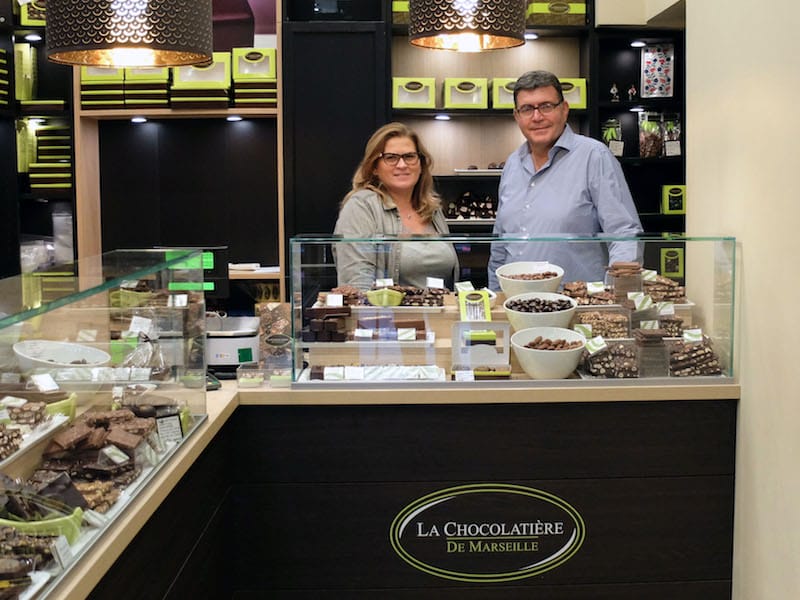
Started in 1901, the historic chocolatier was home to the original barre marseillaise, created by Michèle le Ray, the owner’s granddaughter, in 1971. Over 12 years, Zerrin learned every morsel of the trade, from fabrication to selling. “I love this metier because chocolate makes people happy” she says. But, while she was thankful for Michèle’s savoir-faire, their differing standards, especially with regard to cleanliness, spurred the budding chocolatière to venture out on her own.
Alain offered to join her, eager to create a family business like his parents had done. They found a prime retail location between the Vieux-Port and the pedestrian shopping street of Rue Saint-Ferreol. Each morning the couple crafts chocolates starting at 7 a.m. During the day, Zerrin runs the shop while Alain continues to bake, sometimes as late as 8 p.m. In spite of the long days, when asked how they like working together, they reply, in unison, “It’s super.”
They’re perhaps best known for their barre marseillaise. Though it has a truffle-like texture, the bar is miraculously made without butter or cream. The secret is a praliné of roasted hazelnuts whipped with caramelized sugar, which adds a lightness that traditional truffles lack. Other chocolatiers shape the rectangular bars by hand. Here, they had silicone molds made to achieve the signature matte finish of their chocolate coating.
“I love this metier because chocolate makes people happy” she says.
Choose from seven flavors in dark and milk chocolate, from cocoa nibs (gruet) to a decadent pistachio, in which pistachio paste is layered with the praline. Most popular is the feuilletée, layered with crunchy bits of flaky Breton butter wafers (crêpes dentelle). Though you might be tempted to bite into the bars, Zerrin recommends slicing them into thin wafers, like she does at the shop with customers (samples were always on hand before Covid-19). This is how we first tasted the barre marseillaise – and experienced how it deliciously melts in your mouth.
“We are not masters,” Zerrin says humbly, referring to the esteemed maître designation for culinary professionals in France. Yet their chocolate is phenomenal. Unlike some chocolatiers who make their products in advance, freeze and defrost, everything at La Chocolatière de Marseille is made fresh.
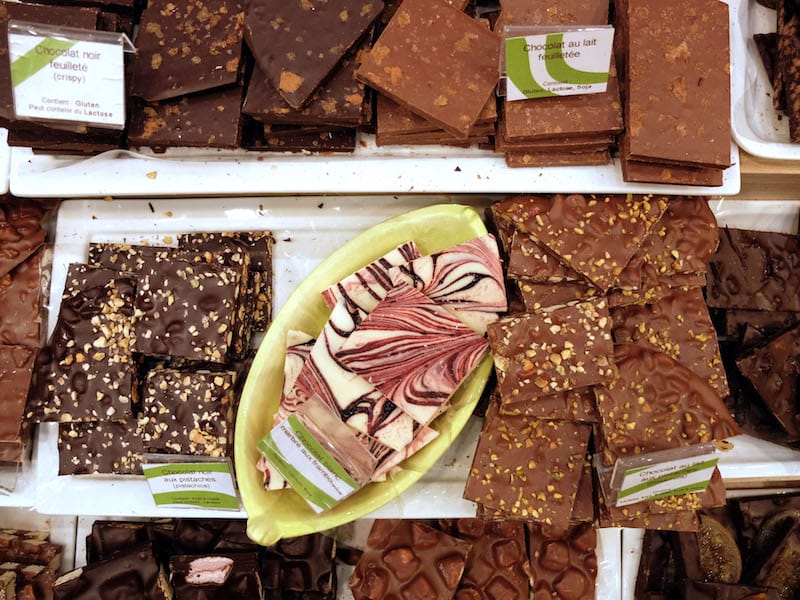
In the pre-Covid days, we would regularly pop in for a giant box of mixed chocolates en route to a dinner party. Now, though, we settle for something small to enjoy at home. In addition to the bars, there are tasty tablettes, giant slabs of dark, milk and white chocolate flavored with high-quality ingredients – like local piment d’Espelette (a mildly hot chile pepper), pistachios from Iran or amarena cherries from Italy – and then broken into rustic pieces. If we’re not in a chocolate mood, we go for the pâtes de fruit, sugarcoated squares of fruit jelly eaten throughout France, or calissons, the specialty candy from Aix-en-Provence made of almond-and-melon paste. Both are produced by regional artisans who specialize in confiseries (candy).
The bright yellow treats are part of the treize desserts de Noël (13 desserts of Christmas) in Provence, as is the nougat peppered with nuts and orange. The holidays account for 30 percent of the chocolatier’s yearly sales – with the Christmas tree-shaped barre marseillaise a popular gift.
In the 19th century, when Marseille’s port was at its most prominent, ships arrived with African chocolate that was transported throughout Europe. Now, La Chocolatière de Marseille ships their confections to customers across France, including those that became fans during trips to Marseille. As a small shop, they don’t have the resources to ship beyond the EU. But you can sample the barre marseillaise in our Marseille Gift Box no matter where you live.
 April 9, 2020 Vive Le Pâques
April 9, 2020 Vive Le Pâques
Though half of France’s population is officially Catholic, only 5 percent of the country […] Posted in Marseille May 8, 2020 Health Food
May 8, 2020 Health Food
Oaxaca’s natural food projects have long had a presence in the city, but they are […] Posted in Oaxaca January 3, 2019 Raising the Bar
January 3, 2019 Raising the Bar
Athens supermarkets devote many shelves to Greek chocolate bars, and there is no […] Posted in Athens
Published on December 04, 2020
Related stories
April 9, 2020
MarseilleThough half of France’s population is officially Catholic, only 5 percent of the country regularly attends mass. Yet, les français still remain faithful to their Christian holidays. After Christmas, Easter is the second-most popular fête – perhaps because it falls on a Sunday, when lunch en famille is a French tradition that is as revered…
May 8, 2020
OaxacaOaxaca’s natural food projects have long had a presence in the city, but they are gaining new importance in light of the current coronavirus crisis. In a time of disruption and disconnection, they see themselves as helping to restore the links between humankind and nature. While the medical and scientific communities are going to great…
January 3, 2019
AthensAthens supermarkets devote many shelves to Greek chocolate bars, and there is no shortage of shops in the city that produce their own chocolates with different fillings as well as truffles, along with other types of sweets. But the past year has seen a chocolate renaissance of sorts: two shops opened which are dedicated exclusively…







































